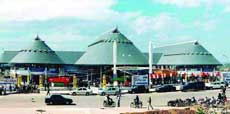Haivan Pass Tunnel
CONSTRUCTION
PROJECT
Welcome to Our Site!
News and Events > Public Media
East-West Corridor expected to usher in prosperity to region
Date: June 09, 2004
A view of the trade centre at the Lao Bao economic zone. — VNA/VNS Photo Duc Duc HCM CITY — Phan Ngoc Nghia, 43, is one of the newly rich in the Khe Sanh - Lao Bao Area of Quang Tri Province.
Nghia and some 50 other residents in the area now have at least VND10 billion (US$650,000) each, having benefited from the promotion of trade across the Lao Bao Border Gate and the development of Highway No. 9, which is part of the East-West Economic Corridor (EWEC).
As a result of incentives issued by the Vietnamese Government for the Lao Bao Economic Zone, Nghia and 32,000 other residents of the Khe Sanh-Lao Bao Area now enjoy duty-free status on all goods transported between Viet Nam and Laos.
The Lao Bao Economic Zone is a major project initiated by the People’s Committee of Quang Tri to pave the way for the East-West Corridor.
The East-West Corridor was proposed by the Asian Development Bank (ADB) in 1998. When complete, it will link Mawlamyine on the Andaman Sea in Myanmar to Da Nang in Viet Nam on the East Sea by a 1,500-kilometer all-weather road running through Myanmar, Thailand, Laos and Viet Nam.
Le Huu Thang, deputy chairman of Quang Tri Province’s People’s Committee, said five districts and two towns in Quang Tri will benefit from the corridor project.
"Quang Tri Province plans to seize this opportunity for economic growth and poverty alleviation programmes," Thang told Viet Nam News last week.
The corridor will reduce coast-to-coast travel time from five to two days.
"The corridor project aims to promote trade and investment among the four countries, to minimise transport expenses, to create more jobs for low-income residents, and contribute to hunger eradication and poverty alleviation in the areas along the corridor," Thang said.
The rich resources of each country are expected to lead to bountiful trade. Northeast Thailand has great potential in the agricultural and consumer goods sectors, while central Laos is rich in agriculture, forestry and mineral and hydropower resources.
Central Viet Nam’s strength lies in its industrial crops, forests and marine and mineral resources.
ADB has said it expects the volume of goods transported along the highway to roughly double between 2000 and 2010 and double again the following decade.
The economic corridor project should also provide 175,000 poor people who live along Highway No. 9 with better access to markets, job opportunities, education and health care, ADB said.
"The challenge for all of us is to make sure the corridor will truly become a full-fledged economic corridor, where the economic and social benefits to be derived from the improved infrastructure are maximised," said Kazu Sakai, deputy director general of ADB’s Mekong Department, during a workshop on corridor development in Savanakhet in February.
In Viet Nam, the corridor will run from Tien Sa Port in Da Nang City through the central province of Thua Thien-Hue to Lao Bao Border in Quang Tri.
The Viet Nam section includes the 180-km stretch of National Highway No. 1A from Da Nang to Dong Ha and a 80-km stretch of Highway No. 9 from Dong Ha to the Lao Bao Border Gate.
Highway No. 9, first built in 1906 when Vietnamese traders established markets in Thakhek and Savannakhet in Laos, also includes the Laos’ 240-km section of the corridor.
Thang said the province will promote exports and expand its markets in Laos and Thailand to better provide transport and transit services, and to tap tourism potential. Three more three-star hotels will be built next year.
One focus of the province is the exploitation of the Lao Bao Economic Zone, located on 15,000 hectares on 25 km along Highway No. 9. It covers five communes and two towns (Lao Bao and Khe Sanh) in Huong Hoa District.
Nineteen investment projects have been licensed for the zone, including three projects with 100 per cent foreign investment. All three projects, capitalised at US$12.3 million, are invested in by Thai companies.
"Thai investors have foreseen the bright future of the Lao Bao Economic Zone when the corridor is complete," said Nguyen Van Cuong, director of Lao Bao Economic Zone Management.
An agreement to exempt visas for tourists between Laos and Thailand is also expected to create a land tourism boom, bringing large groups of visitors from Thailand and Laos to beach resorts in Quang Tri.
"This will help transport on the corridor, allowing a tourist from the northeastern part of Thailand to sunbathe on Cua Tung beach in Quang Tri on a one-day tour," Thang said.
Improvements to the road sections in Laos and Viet Nam are near completion.
Construction of the Hai Van Tunnel in central Viet Nam, linking Hue and Da Nang, and the upgrading of Da Nang port, are progressing.
Construction of the second international bridge spanning Mekong River and linking Thailand and Laos has begun.
Deputy Chairman Thang said Quang Tri has been making preparations for the major economic and social changes expected after the entire East-West Economic Corridor is completed in late 2005. — VNS
(Source: Vietnam News)
This homepage is presented by the Consultant Team
Any further question should be forwarded to Webmaster or Consultant Team
